Migrant workers face dire conditions at South Korean farms
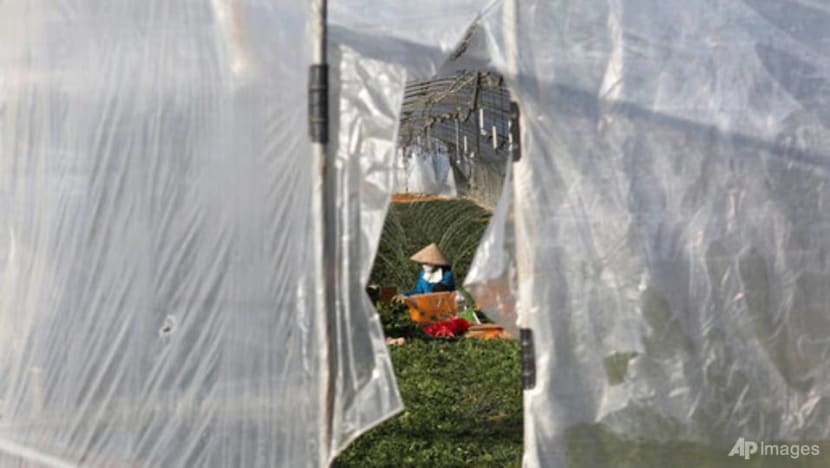
A migrant worker works inside a greenhouse at a farm in Pocheon, South Korea on Feb 8, 2021. (Photo: AP/Ahn Young-joon)
POCHEON, South Korea: “It’s a world of lawlessness,” Reverend Kim Dal-sung muttered over the phone as he drove his tiny KIA over narrow dirt paths zigzagging through greenhouses made of plastic sheets and tubes.
In the bleak landscape of dull blue and grey in Pocheon, a town near South Korea’s ultra-modern capital, hundreds of migrant workers from across Asia toil in harsh conditions, unprotected by labour laws while doing the hardest, lowest-paid farm work most Koreans avoid.
The death of a 31-year-old Cambodian woman worker at one of the farms in December has revived decades-long criticism over South Korean exploitation of some of the poorest, most vulnerable people in Asia. Officials have promised reforms, but it is unclear what will change.
More than two months after Sokkheng’s death, South Korea this week announced plans to improve conditions for migrant farm workers, including expanding healthcare access. Daunted by opposition from farmers, officials chose not to ban using shipping containers as shelter.
On a chilly February afternoon, groups of workers wearing bandanas and conical hats appeared and disappeared among hundreds of translucent tunnel-shaped greenhouses - each about 90m long - harvesting spinach, lettuce and other winter greens and stacking them high in boxes.
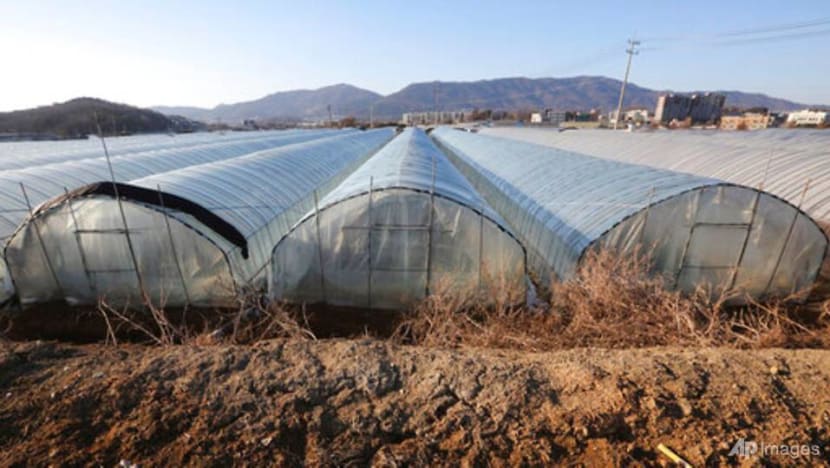
Kim, a pastor and outspoken advocate for migrant workers’ rights, is an unwelcome visitor at the farms in Pocheon, especially after the Cambodian woman, Nuon Sokkheng, was found dead on Dec 20 inside a poorly heated, squalid shelter at one of the farms.
Her death, and those of many others, highlights the often cruel conditions facing migrant workers who have little recourse against their bosses.
“Farm owners here are like absolute monarchs ruling over migrant workers,” Kim said. “Some say they want to kill me.”
READ: Myanmar domestic worker's death and the problem with the bystander effect, a commentary

There are around 20,000 Asian migrant workers legally working on South Korean farms, mostly from Cambodia, Thailand, Vietnam, Indonesia and Nepal. They were brought in under its Employment Permit System. To keep out undocumented immigrants, it makes it extremely difficult for workers to leave their employers, even when they are grossly overworked or abused.
One Korean farmer watched, scowling with hands on his hips, then got on a tractor and began trailing visiting reporters to prevent his foreign employees from talking to them.
Another shouted and waved her hand furiously as she approached, stopping an interview with two Cambodian workers who went back into a shipping container.
South Korean farmers, too, are suffering. The industry is in decline, hurt by decades of labour shortages and increasing foreign competition. They get by importing labour to work long hours for low pay.
“Who are you to come here?” the woman farm owner fumed. “Do you even know what farming is really like?”
Activists and workers say migrant workers in Pocheon work 10 to 15 hours a day, with only two Saturdays off per month. They earn around US$1,300 to US$1,600 per month, well below the legal minimum wage their contracts are supposed to ensure.

Rising before sunrise, they crouch or bend for hours as they work their way through the huge plastic tunnels at each farm, planting, weeding, picking and thinning crops.
The workers often are crammed in shipping containers or flimsy, poorly ventilated huts, like the one where Sokkheng died.
Activists who interviewed her coworkers say she came to Pocheon in 2016 and died just weeks before she was due to return to Cambodia to spend time with her family.
Sokkheng appeared to have no obvious health problems, but an autopsy showed she died from complications from cirrhosis, likely worsened by the harsh conditions she lived and worked in, the activists say.
She died during a bitter cold snap, when temperatures fell to minus 18 degrees Celsius. The shelter’s heating system was faulty, and others living there went to stay with friends to escape the cold. Sokkheng refused to go, they told activists.
READ: The lawyers doing pro bono work helping migrant workers get 'equal access to justice'
A Nepalese farm worker, who asked that his name not be used because he feared reprisals from his employer, said he was considering running away to find factory work as an undocumented migrant after five years of working for a farmer who he said was abusive and occasionally violent.
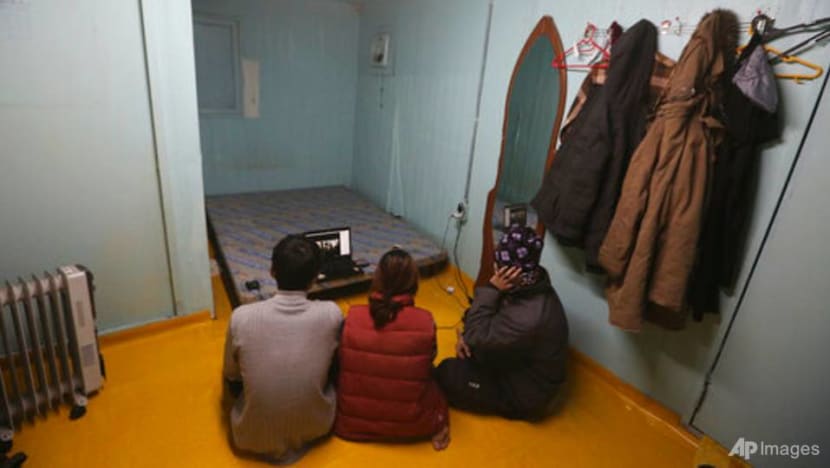
“At least I’ll get more days off,” said the worker, who slipped out to a coffee shop outside the farm one evening for an interview.
“It’s just an extreme amount of work (each day). You don’t get bathroom breaks. You don’t even have time to drink water,” said the Nepalese man. He complained of excruciating back and shoulder pain, likening the situation to slavery.
Just 10 per cent of the 200,000 migrant workers brought to South Korea under its Employment Permit System, or EPS, work on farms. About eight in 10 EPS workers toil in factories, while the rest work in construction, fisheries and service industry jobs.
READ: Thailand’s seafood slavery - Why the abuse of fishermen just won't go away
The Labour Ministry told a lawmaker in October that 90 to 114 EPS workers died each year from 2017 to 2019.
Venerable Linsaro, a Cambodian Buddhist monk based in South Korea, helps with funerals and sending cremated remains to grieving families in Cambodia. He said he knew of at least 19 Cambodian workers who died in 2020. So far in 2021, one farm worker and one worker have been found dead in their shelters.
“Most of them are in their 20s and 30s ... Many of them just died in their sleep,” said Linsaro. He wonders if serious illnesses are going undetected because of workers’ lack of medical access.
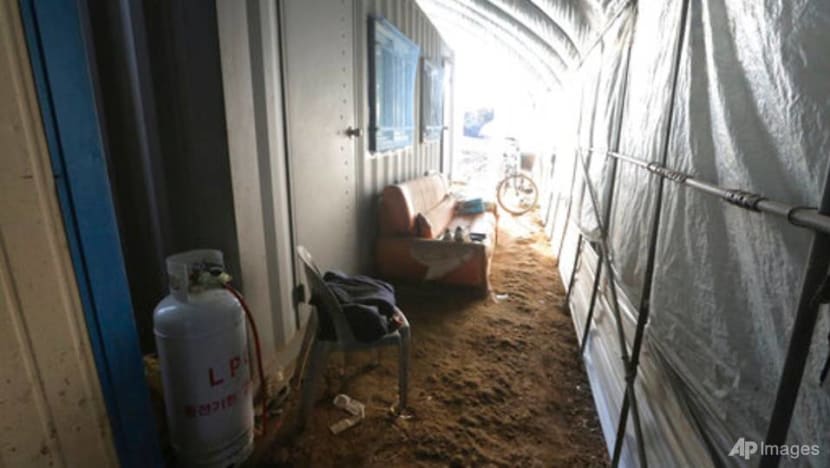
The EPS was launched in 2004, to replace a 1990s industrial trainee system notorious for exposing migrant workers to horrific working conditions.
It was meant to afford migrant workers the same basic legal rights as Koreans. But critics say the current system is even more exploitative and traps workers into a form of servitude.
Migrant farm workers are more vulnerable than factory workers since rules about working hours, breaks and time off do not apply to agriculture. The country’s Labour Standards Act does not apply at all to workplaces with four or less employees, which is typical of many farms.
Choi Jung-kyu, a human rights lawyer, says workers at these farms are virtually unprotected against unjust firings or wage theft, uncompensated for workplace injuries and have scant access to health care.
They often must pay US$90 to US$270 a month to stay in miserable makeshift dormitories that often are just shipping containers equipped with propane tanks for cooking. Such temporary structures usually only have portable toilets.
“The government should absolutely stop letting farms with less than five workers use the EPS,” said Choi.
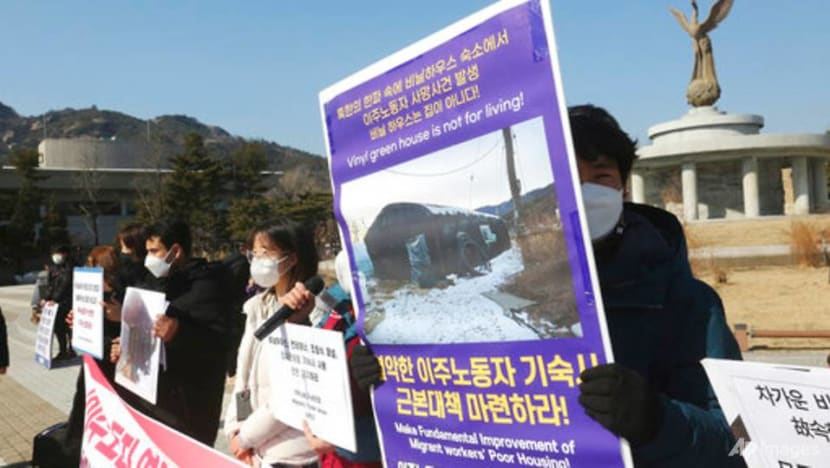
Three Cambodian workers who were interviewed at a Pocheon farm but did not want to be named complained about the gruelling work, South Korea’s bitterly cold winter and harassment by their employer, who calls them “dogs”.
They said they persevere because the wages are better than in Cambodia, giving them a chance to escape poverty.
“I will deal with whatever hardship is thrown at me here,” said one, who is helping to pay for his three siblings’ education. He dreams about buying a farm and a cow when he returns home.
Farmers insist they are barely getting by, too.
“Our farming communities are badly aged,” said Shin Hyun-yoo, leader of a farmers’ association in Gyeonggi Province, where Pocheon is located. “Many will collapse if it becomes harder to hire foreign workers.”












